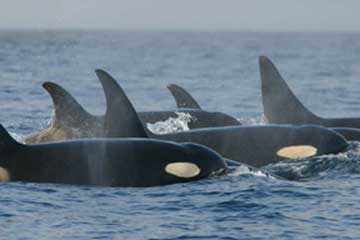Marine Mammal Stock Assessment Reports (SARs)
Overview | Draft Reports | Reports by Region | Reports by Species/Stock
What's New? |
|
 Killer Whales (Orcinus orca) Photo: NOAA |
|
Overview
Section 117 of the Marine Mammal Protection Act (MMPA) requires 3 regional Scientific Review Groups to advise and report on the status of marine mammal stocks within
- Alaskan waters
- Pacific Coast (including Hawaii)
- Atlantic Coast (including the Gulf of Mexico)
The Scientific Review Groups advise NMFS and U.S. Fish and Wildlife Service (FWS) on
- status of stocks
- uncertainties of stocks
- research of stocks, such as research needs, impacts, and methods to reduce incidental mortality of marine mammals incidental to fishing operations
- other issues that the groups or agencies deem appropriate
Do the Agencies Prepare Reports for All Populations of Marine Mammals?
No. The MMPA states that reports must be prepared only for marine mammal stocks that occur in waters under U.S. jurisdiction.
What Information Can I Find in a Stock Assessment Report?
Each stock assessment includes:
- a description of the stock's geographic range
- a "minimum population estimate"
- current population trends
- current and maximum net productivity rates
- "Potential Biological Removal" levels
- status of the stock
- estimates of annual human-caused mortality and serious injury by source
- descriptions of other factors that may be causing a decline or impeding the recovery of "strategic" stocks
How Is the Information Used?
This information is used to
- identify and evaluate the status of marine mammal populations and the effects of human activities upon them
- authorize the "taking" of marine mammals incidental to human activities
- design and conduct appropriate conservation measures
- evaluate the progress of each fishery in reducing its incidental mortality and serious injury to insignificant levels approaching a zero mortality and serious injury rate
How Many Marine Mammal Stock Assessment Reports Are Reviewed or Prepared Annually?
In 1994, we prepared, with FWS, about 165 reports on marine mammal stocks in U.S. waters, including:
- ~60 reports in the Atlantic Ocean and Gulf of Mexico,
- ~60 reports along the Pacific Coast of the continental United States and Hawaii, and
- ~35 reports in Alaska and the North Pacific
- ~10 reports for manatees, polar bears, sea otters, and walrus in U.S. waters (prepared by FWS)
These reports are reviewed and updated annually (strategic stocks) or every three years (non-strategic stocks). The number of reports may vary from year to year because stock identify is subject to change, and marine mammal stocks may be added or removed from the list of compiled reports due to changes in distribution.
- Revisions to Guidelines for Assessing Marine Mammal Stocks (GAMMS II) [pdf]. June 2005.
- NMFS. 2004. A Requirements Plan for Improving the Understanding of the Status of U.S. Protected Marine Species [pdf] [6.1 MB]. Report of the NOAA Fisheries National Task Force for Improving Marine Mammal and Turtle Stock Assessments. U.S. Dep. Commerce, NOAA Tech. Memo. NMFS-F/SPO-63, 112 p.
- Stock Assessment Report Brochure [pdf]. April 2004.
- Wade, Paul R. and Angliss, Robyn P. 1996. Report of the Guidelines for Assessing Marine Mammal Stocks (GAMMS) Workshop [pdf]. Seattle, WA. NOAA Tech. Memo. NMFS-OPR-12, 93p.
- Barlow, Jay, Steven L. Swartz, Thomas C. Eagle, and Paul R. Wade. 1995. U.S. Marine Mammal Stock Assessments: Guidelines for Preparation, Background, and a Summary of the 1995 Assessments [pdf]. U.S. Dep. Commer., NOAA Tech. Memo. NMFS-OPR-6, 73 p.